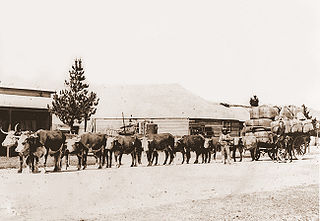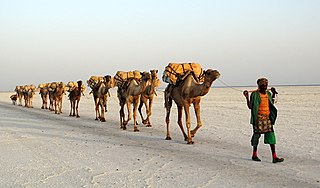 W
WThe following outline is provided as an overview of and topical guide to animal-powered transport:
 W
WA working animal is an animal, usually domesticated, that is kept by humans and trained to perform tasks. They may be pets or draft animals trained to achieve certain tasks, such as guide dogs, assistance dogs, draft horses, or logging elephants. The animals whose tasks include pulling loads are called draught animals or draft animals. Most working animals are either service animals or draft animals. They may also be used for milking or herding. Some, at the end of their working lives, may also be used for meat or other products such as leather.
 W
WA muleteer, or more informally a muleskinner is a person who transports goods using pack animals, especially mules. In South America, muleskinners transport coffee, maize (corn), cork, wheat and myriad other items. They used to be common in the Paisa Region of Colombia but were replaced in the 1950's by tractor trailers called locally "tractomulas" paying homage to the mules that used to do this hard job. In California, muleteers work out of pack stations. In Europe, there are still muleteers in the south of Portugal and the southwest of Spain, in the cork producing area. Their role is now limited to transporting the cork with their mules, out of the Mediterranean oak forest to more accessible routes, where modern means of transport are available.
 W
WA camel train or caravan is a series of camels carrying passengers and goods on a regular or semi-regular service between points. Although they rarely travelled faster than the walking speed of a person, camels' ability to withstand harsh conditions made them ideal for communication and trade in the desert areas of North Africa and the Arabian Peninsula for centuries. Camel trains were also used sparingly elsewhere around the globe. Since the early 20th century they have been largely replaced by motorized vehicles or air traffic.
 W
WA draft horse (US), draught horse (UK) or dray horse, less often called a carthorse, work horse or heavy horse, is a large horse bred to be a working animal doing hard tasks such as plowing and other farm labor. There are a number of breeds, with varying characteristics, but all share common traits of strength, patience, and a docile temperament which made them indispensable to generations of pre-industrial farmers.
 W
WThe true messenger pigeon is a variety of domestic pigeons derived from the wild rock dove, selectively bred for its ability to find its way home over extremely long distances. The rock dove has an innate homing ability, meaning that it will generally return to its nest using magnetoreception. Flights as long as 1,800 km have been recorded by birds in competitive pigeon racing. Their average flying speed over moderate 965 km distances is around 97 km/h and speeds of up to 160 km/h have been observed in top racers for short distances.
 W
WThe horse is a domesticated odd-toed ungulate mammal. It belongs to the taxonomic family Equidae and is one of two extant subspecies of Equus ferus. The horse has evolved over the past 45 to 55 million years from a small multi-toed creature, Eohippus, into the larger, single-hoofed animal of today. Humans began domesticating horses around 4000 BC in Eurasia, and their domestication is believed to have been widespread by 3000 BC. Horses in the subspecies caballus are domesticated, although some domesticated populations live in the wild as feral horses. These feral populations are not true wild horses, as this term is used to describe horses that have never been domesticated, such as the endangered Przewalski's horse, a separate subspecies, and the only remaining true wild horse. There is an extensive, specialized vocabulary used to describe equine-related concepts, covering everything from anatomy to life stages, size, colors, markings, breeds, locomotion, and behavior.
 W
WA pack animal, also known as a sumpter animal or beast of burden, is an individual or type of working animal used by humans as means of transporting materials by attaching them so their weight bears on the animal's back, in contrast to draft animals which pull loads but do not carry them.
 W
WA pack goat is a goat used as a beast of burden, for packing cargo. Generally, large wether goats are used for packing, though does may also be packed. While does are generally smaller and therefore able to carry somewhat less cargo, they may also provide fresh milk.
 W
WA packhorse, pack horse, or sumpter refers to a horse, mule, donkey, or pony used to carry goods on its back, usually in sidebags or panniers. Typically packhorses are used to cross difficult terrain, where the absence of roads prevents the use of wheeled vehicles. Use of packhorses dates from the neolithic period to the present day. Today, westernized nations primarily use packhorses for recreational pursuits, but they are still an important part of everyday transportation of goods throughout much of the third world and have some military uses in rugged regions.
 W
WSkijoring is a winter sport in which a person on skis is pulled by a horse, a dog or a motor vehicle. It is derived from the Norwegian word skikjøring, meaning "ski driving". Although skijoring is said to have originated as a mode of winter travel, it is currently primarily a competitive sport.
 W
WA team boat, horse boat, or horse ferry, is a watercraft powered by horses or mules, generally using a treadmill, which serves as a horse engine. Team boats were popular as ferries in the United States from the mid-1810s to the 1850s.